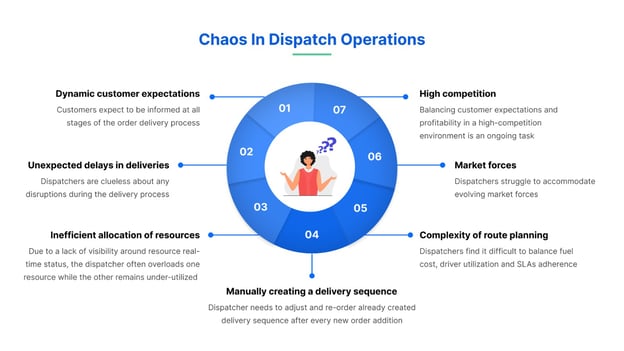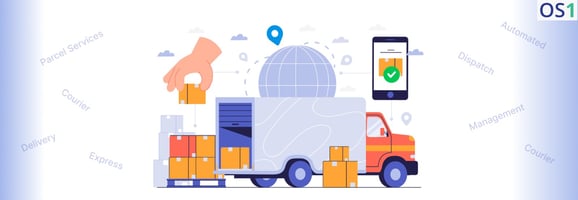In the fast-paced world of logistics, efficiency and optimization greatly affect profitability and...
From Chaos to Control: Simplify Dispatching with Software Automation
With rising customer expectations, changing market conditions, and increasing cost pressures, the business of deliveries could get increasingly complex to manage.
%20(2).jpg?width=936&height=624&name=supply-chain-representation-still-life%20(1)%20(2).jpg)
The delivery experience and SLAs are non-negotiable, given the high stakes involved, whether customer experience or OTIF compliance. However, the variables are too many, with uncertainties at every stage, from unpredictable demand cycles to uncertain driver availability. Unfortunately, most of these variables are outside the control of dispatchers/fulfillment managers who helm the delivery process. The onus is on them to ensure chaos doesn’t completely engulf them and to take control of things despite the many challenges.
Let us take a slightly faraway look at things. More often than not, we find delivery and dispatch teams firefighting and reacting to a problem. Getting caught on the backfoot is never an ideal situation to be in. One of the primary reasons for getting into this situation in the first place is a lack of preparedness. For instance, let us take order volumes. A company getting a sudden spike in order volumes should ideally be in a favorable situation. But, what sets them back is the inability to scale their operations to meet the surge. At this point, decision-making is largely around finding temporary fixes rather than long-lasting solutions. This is where technology solutions play a key role in turning around the situation. With the right technology in place, one can turn chaos into a competitive advantage. A recent Gartner research substantiates this, according to which, by 2024, 50% of delivery businesses will invest in technology to get future-ready.
Chaos in Dispatch Operations
Dispatch operations include a wide range of complex tasks like deciding the order sequence, planning an ideal route & resource allocation, meeting the promised SLAs, scaling the number of deliveries per driver, and many more. The complexity increases manifold when an unpredictable event occurs - for example, a seasonal demand spike.

The compressed delivery windows, coupled with challenges such as rising transportation costs, ever-growing customer expectations, and high competition, demands better operational excellence through innovative solutions.
Speaking of challenges, let’s delve into the complexity of dispatch operations and understand these challenges at a granular level.
Market Forces
Ever-changing customer expectations, technological advancements, and high competition are fundamental market forces that directly influence the cost of logistics operations. A dispatcher faces the challenge of keeping up with these evolving market forces and adapting their strategies accordingly. Dispatchers must proactively respond to changing market conditions while ensuring cost-effective logistics operations.
High Competition
The logistics market is saturated with intense competition posing a significant challenge for dispatchers. They constantly struggle to balance customer expectations, operational excellence, and profitability amid staying competitive in the market. It demands a strategic and holistic approach to deliver outstanding service, maintain efficient operations, and generate profits while keeping up with the ever-evolving competition.
Manually creating a delivery sequence
A dispatcher receives many orders from different sources in a day. Specific considerations need to be factored into while planning a delivery sequence.
Traditionally, dispatchers rely on their expertise and time-consuming manual processes to arrange orders. However, in certain cases, last-minute additions or cancellations of orders occur. These changes need to be accommodated in the pre-created delivery sequence. It increases the chances of manual errors and explains the additional burden on dispatchers.
The complexity of route planning
A dispatcher needs to plan an optimal delivery route while considering various constraints such as vehicle limitations, peak hour traffic, delivery windows, and resource limitations.
Even though the delivery sequence is created efficiently to carry out multiple deliveries within a single route, the dispatcher may struggle to adapt to last-minute additions/ cancellations or on-ground disruptions.
Inefficient allocation of resources
Dispatchers have limited visibility of on-ground resources while assigning tasks to them. On top of it, the daily roaster is created manually. This process might seem easy while dealing with a small number of deliveries.
However, as the number of deliveries grows, dispatchers often face the challenge of proper workload allocation. Consequently, there is a tendency to double-book some resources while leaving others underutilized or idle.
Unexpected delays in deliveries
Despite a dispatcher's holistic approach to planning comprehensive dispatch operations, unforeseen on-ground exceptions can still lead to delays or missed deliveries. The lack of visibility into the process and uninformed incidents make it difficult for the dispatcher to address these issues and proactively ensure timely and successful deliveries.
Rapidly changing customer expectations
Customers expect a convenient and quick delivery experience. A recent salesforce survey explains that 89% of your customers are more likely to make another purchase after a positive customer service experience.
In addition to managing the fulfillment cycle, the dispatcher needs to keep the end customers informed about the real-time status of their orders. Your customer expects that their every single requirement must be accommodated as a priority. Balancing the need to meet customer expectations with cost control in the fulfillment process becomes a two-way challenge for dispatchers.
Impact of Chaos on your dispatch operations
Inefficient and complex dispatch operations significantly risk your business's bottom line, operational costs, resource utilization, and customer satisfaction. Knowing the root cause and underlying reasons is essential to minimize the risks.
We have further broken down the possible reasons for every challenge (discussed above) a dispatcher faces.
The challenges discussed can be significant business setbacks, impacting operational efficiency and profitability. However, embracing automation offers a chance to control the chaos and turn them into possible growth opportunities.
Automation in Dispatch- Turning Hassles into Opportunities
A dispatch solution harnesses the power of automation and helps the stakeholders to introduce optimal efficiency in their daily tasks. The intelligent integration of dispatch solutions in logistic operations brings complete visibility and coordination of the fulfillment process.
Dispatchers can leverage the automation to plan, allocate and track multiple dispatches while incorporating any last-minute changes in delivery schedules throughout the day.
Integrating automation in dispatch can be a game-changer for businesses looking to expedite deliveries and make dispatch operations seamless and transparent.
Core capabilities of software automation
Automated Order Management
Dispatch software enables dispatchers to leverage powerful automation and create quick dispatch plans based on pre-decided algorithms and configurable workflows. The automated delivery sequence plan is created by intelligently grouping orders with similar routes into batches. It helps streamline the dispatch process, saving valuable time and reducing manual intervention.
Intelligent Allocation Capabilities
Dispatch software provides dispatchers with comprehensive information on available resources, vehicle size, and their real-time location. It helps in making informed decisions while assigning specific tasks. The automated workflows help identify the best suitable resource for a particular job. By allocating tasks to the ideal resources, dispatchers can optimize fleet utilization and maximize the efficiency of on-ground operations.
Seamless Route Optimization
A dispatcher struggles to find an optimal route to provide on-time deliveries while controlling transportation costs and scheduling constraints. Route optimization feature enables the dispatcher to leverage real-time data, advanced algorithms, and automated workflows to create delivery routes. It empowers businesses to meet customer expectations and maintain a competitive edge.
Proactively handling exceptions
Delivery delays due to unexpected on-ground exceptions can be reduced to some extent. Get real-time insights into on-ground activities through advanced dispatch software. It helps to identify events of current and potential delays in real time. By proactively addressing on-ground exceptions, dispatchers can enhance operational efficiency, reduce delivery delays, and ensure better SLA adherence.
Putting automation into practice
Dispatchers have various responsibilities, from controlling operational costs to achieving a better customer experience. Manual intervention, monotonous & time-consuming tasks, and inconsistent visibility during the fulfillment cycle become the default in any dispatch operations.
And that’s why businesses today embrace automation to streamline their dispatch operations. A dispatch software solution can significantly help balance customer satisfaction and the cost-effectiveness of your fulfillment process.
To date, dispatch software has:
- Reduced the time to dispatch
- Enabled making best scheduling decisions
- Maximized optimal on-ground resource efficiency
- Helped in making informed delivery decisions
- Achieved better customer satisfaction
The best way to leverage the above benefits is to invest in a technology that adds automation to your dispatch management processes.
DispatchOne is a dispatch management solution that enables dispatchers/stakeholders from small businesses and enterprises to automate their dispatch operations. The end-to-end dispatch solution reduces dispatch processing time, offers centralized visibility, and streamlines your on-ground operations.
This makes the lives of dispatchers simple by helping them proactively manage their operations and have real-time visibility that can enable them to take timely action and keep chaos at bay.
For drivers, they have a much better sense of clarity and can focus on delivering more instead of figuring the sequence or getting entangled in back and forth communication.
For customers, it guarantees a transparent and a predictable experience with zero ‘where is my order’ calls and associated anxiety.
With tight competitive forces and the battle for customer retention, loyalty and positive brand recall, chaos is definitely a huge setback that enterprises cannot afford. With the right set of tools such as DispatchOne in place, they can focus on other core business while the onus of running chaos-free operations is on the dispatch management software.


